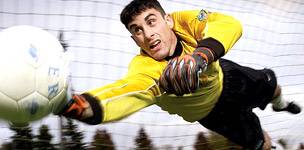Athletes and sports enthusiasts need the best possible vision so they don’t risk eye injuries during rough sports.You may want to consider wearing corrective contact lenses only at night, in a method known as orthokeratology (ortho-k) or corneal refractive therapy.
Why, When, & What Are the Advantages of Ortho-K over Eyewear & LASIK.
With Ortho-K eye-shaping lenses, you don’t need to wear contact lenses or eyeglasses at all while you are awake. With orthokeratology, you can have stable vision correction with unrestricted peripheral vision crucial for sports such as basketball and baseball. Depending on the kind of vision error you have, you also are likely to achieve crystal-clear central vision with this option.
Ortho-k: The Best-Kept Secret of Sports Vision?
Because contact lenses or LASIK eye surgery are popular options for athletes, it’s possible that you’ve never even heard of orthokeratology. In its early stages of development, ortho-k was not as popular an option because outcomes weren’t as predictable.
But today’s orthokeratology methods are far more sophisticated and result in a safe, reversible, non-surgical way of correcting nearsightedness and astigmatism.
Ortho-k is safe and entirely reversible, so it’s an ideal option for athletes who are too young for LASIK. Two trademarked corneal reshaping procedures have FDA approval: Paragon CRT from Paragon Vision Science, and Bausch + Lomb’s Vision Shaping Treatment (VST).
This reshaping of the front of the eye corrects nearsightedness and astigmatism in a way that is similar to a LASIK procedure and other refractive surgery, except that effects are reversible.
Ortho-k contact lenses typically are worn at night during sleep and removed the next morning. Depending on the degree of your nearsightedness or astigmatism and other factors, you may notice a significant improvement in your uncorrected visual acuity even after the very first night of wearing the lenses.
Why Ortho-k May Be Better Than Contact Lenses
Most professional and amateur athletes choose contact lenses as their preferred method of vision correction. Contacts provide more natural vision than eyeglasses. They don’t fog up or get splattered with rain, mud or perspiration. They also provide more stable vision during quick head and body movements, and give you excellent peripheral vision and a wide field of view.
But contact lenses also have drawbacks:
They can dry out, especially during periods of intense concentration when an athlete may not blink frequently enough to keep them moistened. If they become too dry, vision can fluctuate. Contact lenses can sometimes move off center or become dislodged from the eye, especially during contact sports or if they become dry.
Contact lenses sometimes don’t correct astigmatism as well as eyeglasses do. Soft contact lenses for astigmatism can rotate on the eye during certain head movements and postures, causing unstable vision. Some athletes either cannot tolerate the sensation of contact lenses on their eyes or don’t want to deal with the inconvenience of daily lens care and applying and removing the lenses. Eye allergies can be a problem for contact lens wear. Athletes who normally can wear contact lenses successfully may find their contacts become intolerable during allergy season, when pollen and other airborne irritants can stick to the lenses.
Ortho-k, on the other hand, eliminates these contact lens-related vision problems and poses no more risk of contact lens-related eye infections than wearing soft contact lenses.
Why Ortho-k May Be Better Than LASIK or Vision Correction Surgery.
In recent years, many athletes have turned to LASIK to correct their eyesight. While surgical vision correction offers the ultimate in convenience and eliminates contact lens-related problems, it has its own set of drawbacks:
Like any surgery, there is no guarantee of a perfect outcome with LASIK or other vision correction procedures. However, there are risks of complications from LASIK and other vision correction procedures. Possible complications include glare and halos around lights, persistent dry eyes and reduced visual acuity or contrast sensitivity. You must be over 18 for most surgical vision correction procedures, eliminating LASIK and related surgeries as options for younger athletes.
Ortho-k, on the other hand, is safe and entirely reversible. In fact, ortho-k is so safe that many eye care practitioners are comfortable performing the procedure for children as young as 7 or 8 years old. The reversibility of ortho-k makes it ideal for athletes who are too young for LASIK. Ortho-k can give them good, uncorrected vision for sports in grade school and high school.
Ortho-k and Myopia Control
In addition to its other benefits, ortho-k can potentially reduce the progression of myopia (nearsightedness) in children and teenagers. So if you try ortho-k in your teens and then decide to discontinue wearing the reshaping lenses later in life, you may be less nearsighted as an adult than you would be if you had worn eyeglasses or conventional soft contact lenses during your teen years.
Why Ortho-k Might Be Ideal for Certain Athletes
Many athletes who have undergone the ortho-k process report positive feedback such as:
- Greater confidence in their vision.
- Less worry about eye problems and fluctuating vision.
- No concerns about glasses or contact lenses getting knocked off or out during competition.
- No need to bring spare contacts and contact lens solutions to practice and game days.
- No worry about potential complications of refractive surgery, which could adversely affect athletic performance for a lifetime.
While ortho-k can benefit most athletes, sports for which the ability to see without glasses or contact lenses is especially important include archery, boxing, baseball, basketball, climbing, cycling, diving, football, golf, gymnastics, hockey, hunting, martial arts, motorcycle racing, rugby, shooting sports, softball, skiing, snowboarding, soccer, surfing, swimming, tennis and wrestling.
To find out if you’re a good candidate for ortho-k, call Dr. Ezra Cohen today!
